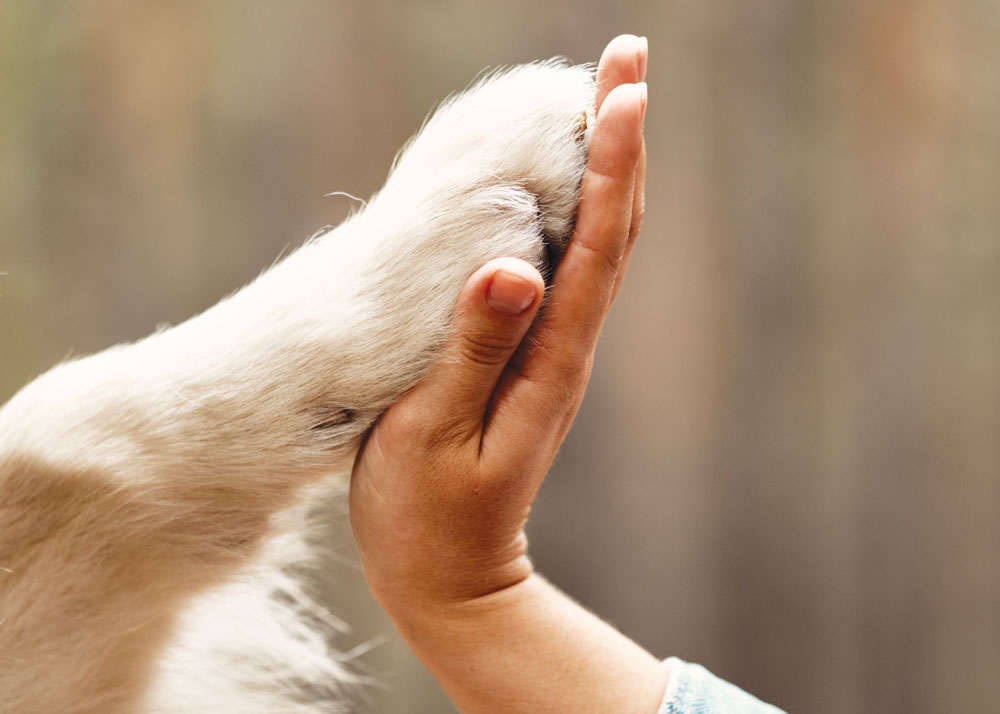

12 Ways To Make Your Dog Smarter & Happier
Expert tips to boost your dog's mood and engage their mind
Worried your dog may be bored or not learning enough? Follow these tips to boost their mood and keep them engaged.
Photo Life on White/bigstock.com
#1 Allow your dog time to stop and smell. Your dog “sees” the world largely through his olfactory senses. The part of the dog’s brain responsible for processing scent is approximately 40 percent larger than a human’s is. Plus, they have up to 300 million scent receptors, compared to our comparatively paltry six million. Walks aren’t just about physical exercise, they’re about mental stimulation too.
⇒ Pro Tip: bring very small treats (you can break them up) or kibble with you and scatter it in the grass, allowing your dog to use her nose to forage.
Photo Glazunov E./bigstock.com
#2 Spend engaged time together. For both of your sake, don’t spend your walks on autopilot—or on your phone. A 2019 survey commissioned by Forthglade Natural Pet Food found that almost two thirds of U.K. dog owners were unable to switch off from screen time while on dog walks. The survey of 1,500 dog people found that 63 percent regularly use their phone while out on dog walks to send texts (50 percent), chat with friends (48 percent), check work emails (27 percent), post on social media (26 percent), shop online (14 percent), and even use online dating apps (7 percent). Instead, engage in a mindfulness practice, focusing on the sights and sounds on your walk. Time in nature has been shown to improve your mood—but only if you’re present enough to reap the benefits. A study reported in the Journal of Environmental Psychology found that time in nature only predicts well-being when individuals are also emotionally attuned to nature’s beauty.
⇒ Pro Tip: Leave your phone at home. If your dog is too revved up, pulling or barking, bring some high reward treats and stop every few paces to ask for a behaviour, even just a “sit.” This will help your dog engage his brain and focus his energy instead of just charging ahead. It’s the journey, not the destination, after all.
Photo lenka2194/bigstock.com
#3 Explore new routes—even just one block over provides new sights and scents.
⇒ Pro Tip: You don’t need to venture far. Walk the same route but set out in the direction you normally finish in. Or simply switch to the other side of the street. Even tiny changes allow us to be more attuned to our surroundings and thus more present, while providing new terrain for our pups.
Photo Sonjachnyj/bigstock.com
#4 Pair words with reliable outcomes. There’s a good reason your dog knows “treat,” “walk,” and perhaps even “cheese”—they always result in the same outcome (i.e., being given a treat or taken for a walk). Expand your dog’s vocabulary by reliably pairing more words with outcomes. A few to try: “car,” “bedtime,” and even phrases like, “Do you want to come?”
Photo Bondarenko.pro/bigstock.com
#5 Keep training sessions fun—and short. The average adult dog can remain focused for up to 30 minutes at a time, says Stanley Coren, Psychology Professor, neuropsychological researcher, and writer on the intelligence, mental abilities, and history of dogs. For puppies, that drops to under a minute. “At around six months, a puppy can hold focus on something interesting for 30 to 45 seconds before focus wanders,” says Coren. “They may come back to focus on the same situation after respite of 20 to 30 seconds.”
Photo stylefoto24/shutterstock.com
#6 Teach names for toys. Repetition is the key here. Introduce one or two toys by name and reward for successfully retrieval. For most dogs this take regular practice, though “gifted” dogs learn new words after hearing them just four times, a recent study has found. “Such rapid learning is similar to the way children acquire vocabulary, around age two or three,” says the co-author of the study. The researchers noted that dogs able to learn the name of their new toy after hearing it just four times while playing with their owners were limited to a select few “genius” dogs. For everyone else, with practice and regular repetition most dogs can be trained to retrieve some toys by name.
Photo Lightman_pic/bigstock.com
#7 Talk the sweet talk. It’s not just what you say, it’s how you say it. Turns out there’s a good reason many of us default to baby talk with our pups. MRI studies have shown that dogs respond best to happy, higher pitched tones, similar to those frequently used with children or dog-directed speech (baby talk).
Photo amazon.com
#8 Try talking buttons. Christina Hunger and her dog Stella caused a sensation when videos of Stella “talking” by using buttons that say words went viral. Stella now knows more than 45 words and can combine them into phrases to communicate. Want to get started? Read the article for a Q & A with Hunger.
Photo GoodStudio/bigstock.com
#9 Use hand signals. Dogs are visual learners. If you don’t already, start pairing commands, such as “sit” or “lie down,” with a distinct hand motion, such as an upward motion with your hand for “sit” or your arm held in the air for “lie down.” Be consistent with your cues—always use the same words/gestures.
Photo Xolodan/bigstock.com
#10 Teach your dog tricks. “Sometimes dismissed as frivolous or silly, tricks are actually a great way to make daily training with our dogs both fun and dynamic,” says Sassafras Lowrey, CTDI (Certified Trick Dog Instructor) and author of Tricks In The City. “With options that are safe and ideal for dogs of all ages and sizes, trick training is a highly adaptable and accessible activity. It’s even a competitive sport with titles that can be earned via video with the American Kennel Club, the Canadian Kennel Club and organizations like Do More With Your Dog. Trick training makes learning fun and provides an excellent opportunity to strengthen relationships with our dogs. In addition, trick training is an excellent way to build confidence for both dogs and people.
“When getting started with tricks, work with your dog’s strengths and the things you already enjoy doing together,” she continues. “If your dog enjoys digging and pawing, teaching high 5, wave or shake can be a great place to start. If you have a ball-obsessed dog, tricks like cleaning up their toys or playing basketball or soccer can be fun tricks to work towards.”
Photo jirkaejc/bigstock.com
#11 Make them work for their food. Most dogs are tremendously food motivated. Take advantage of this to brush up on skills your dog has already mastered, like sit or down-stay.
Photo nina-ottosson.com
#12 Engage your dog’s mind with interactive brain games. Nina Ottosson makes perhaps the coolest canine brain-twisters out there. With various degrees of difficulty, there’s a fit for every dog. Pair these toys with treats and let your dog puzzle out how to get the reward by pawing flaps and maneuvering puzzle pieces to get to the prize. Challenge levels range from beginner to expert. ($30, outwardhound.com)
Join the newsletter and never miss out on dog content again!
"*" indicates required fields
By clicking the arrow, you agree to our web Terms of Use and Privacy & Cookie Policy. Easy unsubscribe links are provided in every email.

















